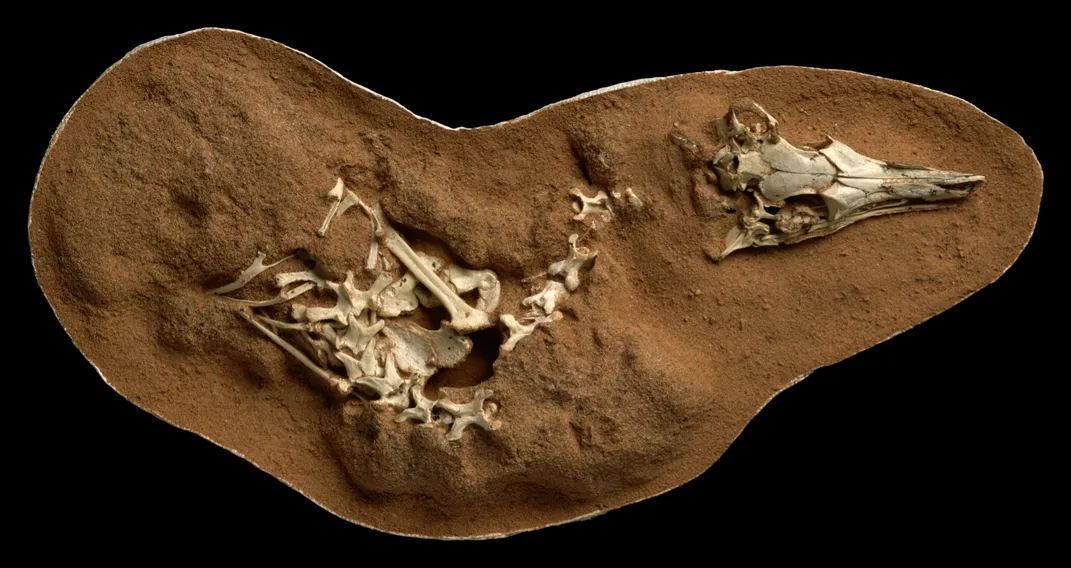Big Eyes and Long Inner Ears Helped This Tiny, Owl-Like Dinosaur Hunt at Night
The chicken-sized Shuvuuia dinosaur had a fragile, birdlike skull, one-clawed hands and long skinny legs
/https://tf-cmsv2-smithsonianmag-media.s3.amazonaws.com/filer/4a/ec/4aec0176-1dbf-47eb-b6b2-1327b226f7c1/7-shuuvia.png)
Paleontologists have long wondered what went on inside of dinosaurs’ heads. A new study published on May 7 in the journal Science uses CT scans to get a closer look.
The research focuses on the shape of part of the ear canal called the lagena. The size and shape of the lagena determine what sounds an animal can hear—the bigger the lagena relative to the skull, the more sensitive the ear. The researchers scanned almost 100 species’ skulls from dinosaur fossils and modern birds to uncover details about the extinct animals’ day-to-day lives.
“Studying the past really requires studying the present, too,” says University of the Witwatersrand paleontologist Jonah Choiniere to Cameron Duke at New Scientist. “The biodiversity we see today is an extraordinary window to the lifestyles of animals from long ago.”

The lagena of a chicken-sized dinosaur named Shuvuuia deserti stood out from the pack. The shape was so long, the researchers thought they may have made a mistake with the measurement, until they scanned the other side of the fossil skull and found the same result.
"Shuvuuia had proportionally longer cochlear ducts than even the bird with the best hearing: the barn owl," says Choiniere to Live Science’s Mindy Weisberger.
Barn owls’ hearing is notoriously precise, especially at the frequencies of squeaking mice and voles. Some scientists have suggested that their hearing allows owls to hunt in total darkness if they know the lay of the land. So the researchers decided to take a look at the Shuvuuia’s eyes to see if they were also adapted for nighttime excursions.
Based on the size of the fossil’s scleral rings, which are the bones that surround the eyes, the researchers found that Shuvuuia had very large eyes. That would allow it to have large pupils, all the better to see prey with in low light.
Choiniere tells Live Science that Shuvuuia’s night vision was “better than any living bird we measured.”
By comparing Shuvuuia’s inner ear and eye size to modern birds, the researchers could draw conclusions about its behavior during its lifetime. It lived in the deserts of what is now Mongolia about 65 million years ago, and like many desert animals today, may have adapted to be most active at night.
It may have hunted small mammals or social insects, but co-author Lars Schmitz, a biologist at the Los Angeles County Museum of Natural History, tells Riley Black at National Geographic that many factors, like “body size, foraging style, climate, [and] competition,” all would have influenced how the dinosaur evolved its traits.
The study also showed how other dinosaurs were not well-adapted to hunting at night. The Tyrannosaurus rex’s small eyes were most adapted for activity during the day, while the velociraptor’s mid-sized eyes would have worked best during twilight hours. Even though they and Shuvuuia are all theropods, the tiny dinosaur has a lot of unique characteristics.
Not only are its eyes and ears super-sensitive, but it also had small, strong arms tipped with a single claw each. And it had long, skinny legs like a roadrunner. Shuvuuia could have chased its prey into a burrow, and then used its forelimbs to dig it out, reports Reuters’ Will Dunham.
"This observation that Shuvuuia could have operated at night makes a lot of sense in light of the rest of the adaptations," says Choiniere to Live Science. "It puts those into perspective and allows us to think it would have fit into a desert ecosystem today really well."